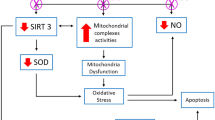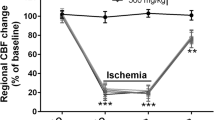Abstract
Grape seed proanthocyanidin extract (GSPE), a polyphenolic compound with antioxidant properties, may protect against cardiac ischemia and reperfusion injury. However, its potential toxicity at higher doses is unknown. The authors tested the effects of GSPE on reactive oxygen species (ROS) generation, cell survival, lactate dehydrogenase (LDH) release, and caspase-3 activity using chick cardiomyocytes incubated with GSPE at 5, 10, 50, 100, or 500 μg/mL in medium for 8 h. Exposure to increasing concentrations of GSPE (100 or 500 μg/mL) resulted in an increase in ROS generation and cell death as measured by propidium iodide uptake and LDH release. Caspase-3 activity was significantly increased fourfold in cells exposed to GSPE 500 μg/mL compared to controls; this was abolished by the selective caspase-3 inhibitor AC-Asp-Gln-Thr-Asp-H(50 μM), which aslso significantly reduced the cell death resulting from GSPE (500 μg/mL). The antioxidant N-acetylcysteine (NAC, 100 μM) reduced cell death induced by GSPE (500 μg/mL) but failed to attenuate caspase-3 activation. Collectively, the authors conclude that higher doses of GSPE could cause apoptotic cell injury via effector caspase-3 activation and subsequent induction of ROS generation. Consumers may take higher doses of dietary supplements in the belief that natural herbs have no major side effects. This study demonstrates that dosages of GSPE should be optimized to avoid potential harmful pro-oxidant effects.
Similar content being viewed by others
References
Facino, R. M., Carini, M., Aldini, G., Berti, F., Rossoni, G., Bombardelli, E., et al. (1996). Procyanidins from vitis vinifera seeds protect rabbit heart from ischemia/reperfusion injury: antioxidant intervention and/or iron and copper sequestering activity. Planta. Med. 62:495–502.
Pietri, S., Maurelli, E., Drieu, K., and Culcasi, M. (1997). Cardioprotective and anti-oxidant effects of the terpenoid constituents of Ginkgo biloba extract (EGb 761). J. Mol. Cell. Cardiol. 29:733–742.
Yu, X. C., Wu, S., Wang, G. Y., Shan, J., Wong, T. M., Chen, C. F., et al. (2001). Cardiac effects of the extract and active components of radix stephaniae tetrandrae: II. Myocardial infract, arrhythmias, coronary arterial flow and heart rate in the isolated perfused rat heart. Life Sci. 68: 2863–2872.
Facino, R. M., Carini, M., Aldini, G., Berti, F., Rossoni, G., Bombardelli, E., et al. (1999). Diet enriched with procyanidins enhances antioxidant activity and reduces myocardial post-ischaemic damage in rats. Life Sci., 64:627–642.
Sato, M., Maulik, G., Ray, P. S., Bagchi, D., and Das, D.K. (1999). Cardioprotective effects of grape seed proanthocyanidin against ischemic reperfusion injury. J. Mol. Cell. Cardiol. 31:1289–1297.
Bagchi, M., Kuszynski, C. A., Balmoori, J., Joshi, S. S., Stohs, S. J., and Bagchi, D. (2001). Protective effects of antioxidants against smokeless tobacco-induced oxidative stress and modulation of Bcl-2 and p53 genes in human oral keratinocytes. Free Radic. Res. 35:181–194.
Sato, M., Bagchi, D., Tosaki, A., and Das, D. K. (2001). Grape seed proanthocyanidin reduces cardiomyocyte apoptosis by inhibiting ischemia reperfusion-induced activation of JNK-1 and C-JUN. Free Radic. Biol. Med. 31: 729–737.
Roychowdhury, S., Wolf, G., Keilhoff, G., Bagchi, D., and Horn, T. (2001). Protection of primary glial cells by grape seed proanthocyanidin extract against nitrosative/oxidative stress. Nitric Oxide 5:137–149.
Bagchi, D., Sen, C. K., Ray, S. D., Das, D. K., Bagchi, M., Preuss, H. G., et al. (2003). Molecualr mechanisms of cardioprotection by a novel grape seed proanthocyanidin extract. Mutat. Res. 523–524:87–97.
Ray, S., Bagchi, D., Lim, P. M., Bagchi, M., Gross, S. M., Kothari, S. C., et al. (2001). Acute and long-term safety evaluation of a novel IH636 grape seed proanthocyanidin extract. Res. Commun. Mol. Pathol. Pharmacol. 109:165–197.
Shao, Z. H., Becker, L. B., Vanden Hoek, T. L., et al. (2003). Grape seed proanthocyanidin extract attenuates oxidant injury in cardiomyocytes. Pharmacol. Res. 47:463–469.
Cohen, G. M. (1997). Caspases: the executioners of apoptosis. Biochem. J. 326(Pt. 1):1–16.
Strasser, A., O’Connor, L., and Dixit, V. M. (2000). Apoptosis signaling. Annu. Rev. Biochem. 69:217–245.
Hayakawa, K., Takemura, G., Koda, M., Kawase, Y., Maruyama, R., Li, Y., et al. (2002). Sensitivity to apoptosis signal, clearance rate, and ultrastructure of fas ligand-induced apoptosis in in vivo adult cardiac cells. Circulation 105:3039–3045.
Vanden Hoek, T. L., Qin, Y., Wojcik, K., Li, C. Q., Shao, Z. H., Anderson, T., et al. (2003). Reperfusion, not simulated ischemia, initiates intrinsic apoptosis injury in chick cardiomyocytes. Am. J. Physiol. Heart Circ. Physiol. 284: H141-H150.
Vanden Hoek, T. L., Li, C., Shao, Z., Schumacker, P. T., and Becker, L. B. (1997). Significant levels of oxidants are generated by isolated cardiomyocytes during ischemia prior to reperfusion. J. Mol. Cell. Cardiol. 29:2571–2583.
Vanden Hoek, T. L., Shao, Z., Li, C., Schumacker, P. T., and Becker, L. B. (1997). Mitochondrial electron transport can become a significant source of oxidative injury in cardiomyocytes. J. Mol. Cell. Cardiol. 29:2441–2450.
Ye, X., Krohn, R. L., Liu, W., Joshi, S. S., Kuszynski, C. A., McGinn, T. R., et al. (1999). The cytotoxic effects of a novel IH636 grape seed proanthocyanidin extract on cultured human cancer cells. Mol. Cell. Biochem. 196: 99–108.
Agarwal, C., Singh, R. P., and Agarwal, R. (2002). Grape seed extract induces apoptotic death of human prostate carcinoma DU145 cells via caspases activation accompanied by dissipation of mitochondrial membrane potential and cytochrome c release. Carcinogenesis 23:1869–1876.
Pataki, T., Bak, I., Kovacs, P., Bagchi, D., Das, D. K., and Tosaki, A. (2002). Grape seed proanthocyanidins improved cardiac recovery during reperfusion after ischemia in isolated rat hearts. Am. J. Clin. Nutr. 75:894–899.
Shao, Z. H., Li, C. Q., Vanden Hoek, T. L., Becker, L. B., Schumacker, P. T., Wu, J. A., et al. (1999). Extract from Scutellaria baicalensis Georgi attenuates oxidant stress in cardiomyocytes. J. Mol. Cell. Cardiol. 31:1885–1895.
Shao, Z., Li, C., Becker, L. B., Vanden Hoek, T. L., Schumacker, P. T., Attele, A. S., et al. (2001). Qian-Kun-Nin, a Chinese herbal medicine formulation, attenuates mitochondrial oxidant stress in cardiomyocytes. J. Ethnopharmacol. 74:63–68.
Thornberry, N. A., and Lazebnik, Y. (1998). Caspases: enemies within. Science 281:1312–1316.
Picq, M., Dubois, M., Munari-Silem, Y., Prigent, A. F., and Pacheco, H (1989). Flavonoid modulation of protein kinase C activation. Life Sci. 44:1563–1571.
Author information
Authors and Affiliations
Corresponding author
Additional information
Terry L. Vanden Hoek and Zuo-Hui Shao are equal contributors to this work.
Rights and permissions
About this article
Cite this article
Shao, ZH., Vanden Hoek, T.L., Xie, J. et al. Grape seed proanthocyanidins induce pro-oxidant toxicity in cardiomyocytes. Cardiovasc Toxicol 3, 331–339 (2003). https://doi.org/10.1385/CT:3:4:331
Received:
Revised:
Accepted:
Issue Date:
DOI: https://doi.org/10.1385/CT:3:4:331




